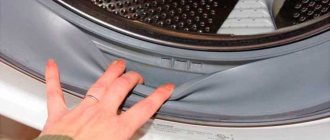Cotton is a fiber of plant origin. Due to its durability and low cost, it is in great demand.
However, it is important to handle it correctly. After all, like many other fabrics of natural origin, cotton (it is also called “cotton” in English) is prone to deformation when interacting with water and heating.
Does cotton shrink after washing and why does this happen, how to prevent shrinkage and correct the situation if the item does shrink? You will find answers to questions in the article.
Shrinkage and its causes
If you are not careful when processing cotton fabrics (for example, chintz, cambric, satin and others), they can:
- sit down (be subject to deformation);
- turn yellow;
- shed.
The material shrinks both in length and width. In order to properly care for such fabrics, you need to understand why their size changes.
Why does 100 percent cotton shrink?
The reduction in the original size of cotton is largely due to the structure of the fibers. The raw material for the production of the material is the fluffy mass of cotton fruits.
Textile threads are thoroughly stretched during the manufacturing process . When in contact with water and heat treatment, cotton fabrics swell, and when dried, they change length (shrink).
If decating was carried out correctly during production, the scale of shrinkage is much less. Decatation is the processing of textiles (wet-thermal) during the production process. Its purpose is to pre-shrink fabrics before cutting them.
The reason for shrinkage of cotton fabrics is often the incorrectly chosen washing (ironing) temperature.
Is it not 100% deformable?
Artificial fabrics, as a rule, are not prone to shrinkage , which is why adding them to cotton makes it more stable and elastic. Cotton with elastane (satin, stretch cotton, bengalene, gabardine, polyester) has increased stretchability.
When fibers are combined, the texture of the fabric becomes elastic, firm, and shrinks to a lesser extent. However, we must not forget about the temperature compliance when washing and ironing, determined by the product labels.
Evolutionary changes in natural fabrics
Textile production is progressing, equipment is being improved, and innovative production development technologies are being used. That is why in recent years, very often on the labels of T-shirts, dresses, sportswear, and underwear, you can notice that the inscription “100% cotton” is practically absent. Instead, you may see “95% cotton, 5% elastane” or another percentage combination. This is most likely due to the fact that manufacturers began to add elastane threads to achieve the elasticity that cotton so lacks. And not in order to reduce the level of naturalness in the material, while increasing its synthetic nature.
How to wash, at what temperature?
The first wash of 100% cotton products is especially important. a new item must be washed by hand in warm (30°C) water , after soaking for 10-20 minutes.
In the future, the water temperature should not exceed 60°C (40°C for delicate washing).
Valuable information about the rules for washing a cotton product can be obtained by studying the label . From the label you can understand what temperature conditions are optimal, how to dry cotton products, and what products are best to use. The tag also contains information about which wash is preferable: hand or machine.
To save themselves from unpleasant surprises with cotton products, some people buy items one size larger and wear them with pleasure after washing.
Learn more about washing cotton here.
In the typewriter
After reading the label that allows you to wash a cotton product in a washing machine, follow these steps:
- sorting by fabric type and color to eliminate shedding;
- sorting by contamination (the cleaner the fabric, the more gentle the treatment is provided);
- early removal of contaminants manually;
- turning products inside out;
- fastening buttons;
- putting small things in nets;
- selection of the optimal temperature regime (not higher than 60°C, and for thin fabrics - 40°C).
The likelihood of shrinkage decreases as the speed decreases during the drying process (up to 400). Thin cotton fabric should be washed in a delicate program without drying or spinning at all.
Modern machines have special modes, for example: “Cotton: intensive wash”, “Colored cotton”, etc.
Hands
You need to wash by hand if:
- new clothes;
- the product is thin, delicate (muslin, chintz, etc.), contains decorative elements;
- fabric is prone to shedding.
To wash without using a machine, you need to prepare a soap solution and meet several requirements:
- It is preferable to use grated laundry soap.
- It is better to use special detergents (powders, capsules, gels) for natural materials.
- Before the manual washing process, it will not be superfluous to soak for 10-20 minutes. The water temperature should not exceed 40°C, as well as during the subsequent washing process.
- There is no need to wring out the item too much, as the fibers may be damaged.
Rinsing at the end of hand washing should be thorough, until the soap completely disappears.
Preparation
Preparation for washing occurs according to the following scheme:
- Before the procedure, the product must be turned inside out.
- If the item is heavily soiled, it should be soaked first, otherwise it may not wash off. The washing temperature is too low to remove serious stains.
- Another option for removing stains is to soak the item, just like in the old days. To do this, you need to pour a lot of water into a bowl, add detergent or detergent (you can use ammonia with peroxide) and leave it all for half an hour. After which you need to rinse the item, and the stains should be washed off. When washed by hand, deformation and shrinkage of the item will not occur.
Rules for drying and ironing
It is important to follow several useful recommendations:
- You need to carefully read the product label. It contains a guide to drying rules.
- Drying cotton items in a washing machine is not recommended. Moreover, the fabric shrinks the more, the higher the temperature is set.
To maintain their shape and prevent kinking, cotton clothes should be hung out immediately after washing.- It is recommended to dry the products in a leveled position. It's better to hang them on hangers. This also makes subsequent ironing easier.
- Drying should be done out of direct sunlight.
- If things are dried indoors, there should be no heating devices nearby.
- If possible, do not use clothespins to avoid leaving marks (dents).
- It is important not to overdry the products.
- It is preferable to iron things slightly damp on the reverse side, gently stretching the fabric to give the desired size.
- If things are still dry, moisten them using the special function on the iron. If it is not available, you can simply spray the products with water.
After finishing the ironing process, items should be completely dry to avoid re-shrinkage.
Behavior of cotton after washing
Any cotton product shrinks a little after washing. This is explained by the structure of cotton fiber. The raw material for fabrics is cotton wool, from which loose threads are obtained. After interacting with water, the fibers stick together, resulting in a decrease in the size of the fabric. The higher the water temperature, the more the material shrinks. If not properly cleaned, clothing sizes may decrease by 5% in length and 2% in width.
Cotton knitwear will stretch in width and shrink in length after washing. Clothes made from this material should be washed very carefully, only by hand, do not twist them, and dry them by laying them out on a horizontal surface.
What to do if the item shrinks?
There are a number of ways to return cotton items to their original sizes. Here are some of them:
1 way
Prepare water. It should not be hot, about 30°C. Soak the “shrunken” item for an hour and a half. Wash it in a machine at the same temperature in the “delicate wash” mode.
After removal, lightly squeeze the product and carefully stretch it by hand to the required size . The stretching process can be repeated several times.
During drying, if necessary, continue stretching the fabric to give it the desired shape and achieve the desired size.
Method 2
Another option for stretching the product is ironing with steaming (you can use thin damp gauze). During the ironing process, you should stretch the fabric with your hands in the desired direction. Cotton is thermoplastic, so fabrics made from it “remember” the shape they are given when ironed.
3 way
Rinse shrinked cotton products in water, which is diluted with hydrogen peroxide (2-4 spoons per 10 liters of water). While rinsing, constantly stretch the product. As an alternative, you can use vinegar. The effect is enhanced by repeated soaking and drying.
It happens that shrinking clothes, on the contrary, is necessary. In this case, you need to do the opposite: wash at high temperatures, use machine drying or drying in a horizontal position.
conclusions
Cotton is a natural material, but not problematic. To prevent it from shrinking or stretching, you need to wash it correctly. In order for it to shrink, you need to follow all the recommendations for washing and drying exactly the opposite. To stretch such fabric, there are three ways:
- We wash and dry in a specific way;
- Soak and rinse in a solution of peroxide or ammonia;
- We stroke, slowly stretching.
And yet, if there is a good tailor shop nearby, it is better to take the cotton item there. Professionals will stretch or fit everything correctly, without harming the thing at all!
Synthetic fibers
Elastane threads are a common type of synthetic fiber that gives elasticity to any textile. Synthetic polyurethane fibers resemble rubber in appearance.
In textile production, these threads are never used in their pure form. They are added to other, more natural fibers.
Elastane fibers include lycra and spandex.
As a result of the addition of such threads, the stretchability of the material increases several times, and the elastic properties increase.
Methods for removing stubborn stains from the surface of cotton products
The less often you wash cotton and the softer the mode you choose, the slower it will shrink. For this reason, stubborn stains should be removed locally, followed by rinsing the fabric in cool water. Cotton removes stains quite easily, you just need to choose the right products:
- It is highly undesirable to use chlorine bleaches to clean white fabric; they wear out the fibers too quickly. It is better to make do with safer and no less effective hydrogen peroxide.
- To remove greasy stains, you will have to use turpentine, ammonia or purified gasoline. They remove dirt without any problems without having a negative effect on the color of the material.
- For more delicate items, you can try glycerin diluted with water. After using it, the dirt will go away, and the texture of the fabric will only improve.
- When dealing with fresh stains, it is recommended to limit yourself to soaking things in cool water with the addition of a gel product based on plant-derived enzymes.
- As a last resort, it is allowed to use stain removers, but only those that do not contain bleaching components.
If these conditions of care are observed, cotton will last a very long time, maintaining its original appearance and shape throughout the entire period of use.











